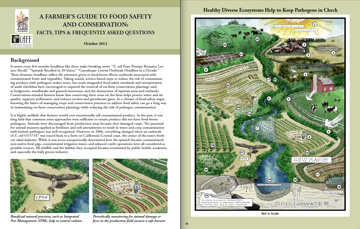We’ve been talking a lot here at NSAC about the problems FDA’s Food Safety Modernization Act proposed rules pose for sustainable agriculture. One of our biggest concerns is with how those rules treat on-farm conservation practices. Our friends at Wild Farm Alliance have put together some great information about sustainable practices that protect both the environment and food safety, and how the FSMA rules as currently written don’t do enough to support these win-win practices. Take a look, and then be sure to tell FDA to do better by commenting on the proposed rules. Only one week left until the November 15 deadline!
—–
By Jo Ann Baumgartner, Wild Farm Alliance
Diversity is the mother of invention, the teacher of tolerance, and the patron of food safety. It so enriches our lives, businesses and society. Diversity of thoughts and ideas contributes to our unfolding understanding of the way our agro-ecosystems work. Diversity of people, and our non-human brethren with whom we share this planet, reminds us not to be egotistical with blinders on. And diversity of organisms that we have co-evolved with keeps us healthy and makes sustainable and organic agriculture tick.
The Rule Itself
As the days wind down before comments to FDA are due on the proposed Produce Rule of the Food Safety Modernization Act (November 15, 2013), it is well worth contemplating the natural diversity that is at stake if we humans veer too far into the sterility mindset and allow our tried and true, and emerging, tools to be taken away in the name of food safety.
Nature on the farm will be compromised without our united voices speaking up for her. It is not enough to have language about how “sustainable conservation practices enhance food safety” in FDA’s preamble to the Produce Rule —FDA must encourage these practices in the Rule itself, or they will be ignored and forgotten, and farmers will have no way to push back when misguided buyers require barren landscapes bereft of all but the crop.
Beyond the Rule
Food safety issues are here to stay. Because of that, Wild Farm Alliance and Community Alliance with Family Farmers have published “A Farmer’s Guide to Food Safety and Conservation”. It describes how diversity confers safety on micro and macro scales— and goes into details of everything from how pathogens get on the farm to factors that affect pathogen survival.
Survival factors, it turns out, have a lot to do with microbial diversity in the soil—the more the diversity, the less the pathogens. Those factors also have to do with above ground diversity. Non-crop vegetation—be it a windbreak or riverside habitat—helps to buffer pathogens from contaminating the crop. Botanical diversity also confers safety in wildlife. When biodiversity is present, rodents shed less pathogens, and when wildlife corridors are intact, growers report deer tend to stay in their preferred habitat. Those corridors also provide avenues for wildlife predators to cruise through while nabbing some rodents.
While wildlife generally have a low risk of carrying pathogens, monitoring for wildlife feces and crop damage yields the safety all farms must have, not only for peace of mind that growers are not making anyone sick, but also for their markets. In the last section of the Guide, we give tips of how to have a successful food safety audit or inspection—a must read for farmers who have never gone through one before. We also published a separate online document for food safety auditors with NSAC’s help—Training Scenarios for USDA and Third Party Auditors on the Co-management of Food Safety and Conservation as well as Small and Mid-Size Farm Concerns. Growers who suggest that their auditors first review these training scenarios before arriving at the farm will have an easier time explaining why their sustainable practices are safe. USDA accredited auditors also receive continuing education units for reviewing them.
We are an ecosystem within an ecosystem. For every one of our human cells, we have ten non-human ones in our bodies. We live on a planet amidst trillions of species. In the absence of this diversity we get sick, our farms are unsafe, and the beauty of the world that feeds our soul is diminished. We don’t yet understand now how all the parts work, but every day there are new insights, and with measures of tolerance and common sense, we will conserve those large and small parts so critical to our ecosystems. Nature abhors a vacuum. Our health relies on the web of relations that should be encouraged on the farm and should be made a foundation of the Produce Rule.



I totally agree with the absolute value of biodiversity. How then is our government supporting the big AGRA and big Pharma in spreading the GMO crops that are destroying the biodiversity and poisoning our food chain?